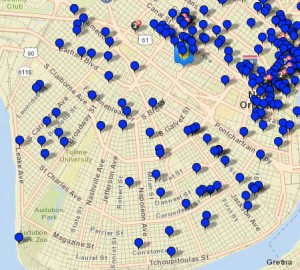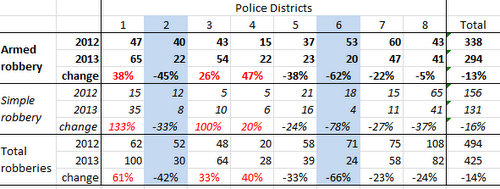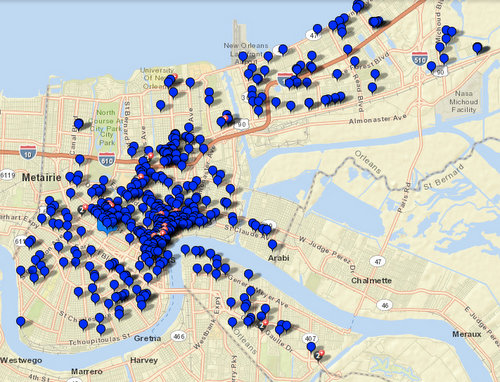
All reported robberies around Uptown New Orleans in 2013. (map via NOPD)
But despite the perception these incidents create, and in spite of a generally shrinking New Orleans Police Department, Uptown has seen a dramatic decrease of 50 percent or more in the number of armed robberies reported in 2013 from the same period of time last year, according to statistics compiled from NOPD sources.
‘Meaningful reduction’

Year-to-date robbery numbers by police district. (Source: NOPD Comstat presentations, June 28, 2013)
Uptown New Orleans is divided fairly neatly into two police districts, divided at Napoleon Avenue: the Sixth District includes Hoffman Triangle, Central City, the Garden District, the Irish Channel and the lower Garden District, while the Second District covers Hollygrove, Carrollton, the university area, Freret and much of Broadmoor.
As of Friday (June 28), the Second District had reported 22 armed robberies for the year, down from 40 this time last year, a 45-percent reduction. The Sixth District had reported 20 armed robberies, down from 53 last year, a reduction of 62 percent. Taken together, the two districts have seen a 55-percent reduction in armed robberies, the statistics show.
“It’s a meaningful reduction,” said Professor George Capowich, a criminologist at Loyola University New Orleans. “If it drops from 100 to 45, there’s no doubt that’s statistically significant.”
(The NOPD tracks armed robberies and simple robberies separately. Adding the simple robberies into the armed robbery numbers do not change the trend much, however; the two districts are down 56% for armed and simple robberies combined, for example.)
The trend for armed robberies is not consistent around the city — three districts have seen reductions, though not as large as in the Second and Sixth, and three have seen increases. In fact, it could be argued that the Second and Sixth District’s improvements over last year account for all the robbery reduction in the city. The NOPD has reported 294 armed robberies this year, down 44 from 338 this time last year — while the Second and Sixth districts are down 51 robberies together.
Focus on ‘hot spots’
NOPD Superintendent Ronal Serpas, speaking at the department-wide Comstat meeting on Friday, attributed the general reduction in violent crime to use of data-driven deployment of patrol vehicles. A NOPD computer system analyzes the frequency of all crime — from the traditional focus areas of rape, robbery and murder down to more trivial incidents such as theft and car crashes — and creates a map of “hot spots” in the district, often as specific as an individual intersection or stretch of a few blocks.
A dedicated officer is then sent to those hot spots, and in theory, his or her presence either convinces potential troublemakers to go elsewhere, or results in an arrest that takes a criminal off the street. Even if that hot spot is nowhere near the site of the nearest robbery — one frequent spot in the Sixth District, for example, is the intersection of Martin Luther King Boulevard and South Claiborne, because of the high number of car crashes, though it is rarely the site of robberies — the pressure on criminals there is intended to reduce the overall amount of crime.
Capowich, the Loyola professor, has been consulting with the NOPD on its implementation of the data-driven policing, and said their approach to these patrols is based on the best research available.
“Random patrol is not very effective all by itself,” Capowich said. “Because crime isn’t random, patrolling randomly — you wouldn’t expect it to be all that effective. … What a directed strategy like that does is it increases uncertainty for the offenders. It looks like, ‘There’s too great a chance I might get caught,’ so they might leave the area.”
Serpas on Friday noted the reduction in violent crime despite a force that’s 20 percent smaller than it was just two or three years ago, and said the only way to explain it is through more effective police deployment. With new recruits now in the academy, more officers should soon be headed onto the street, Serpas said, increasing the manpower available to be dedicated to those directed patrols.
Solving robberies
District commanders — Paul Noel in the Second, and Bob Bardy in the Sixth — offer two additional, somewhat related explanations. In 2012, both districts suffered from several robbery sprees allegedly committed by one person or a small group, such as a “clique” of robbers in the Irish Channel targeting taxi drivers or a rash of robberies in the university area last summer. Such a spree – a handful of robberies in a few days’ time — can push robbery statistics quickly through the roof.
As the year progressed, however, some of those perpetrators were arrested, taking them off the Uptown streets — such as the gang allegedly involved in the carjacking on Camp Street that left attorney Sandy Kaynor severely injured, or the suspect in the Dat Dog robbery. And this year in general has seen a strong pattern of arrests as Noel has made reducing armed robberies the top priority for the district. In the Second District, for example, detectives currently have a 43-percent clearance rate, Noel said — well above the national average of about 25 percent for cities of similar size.
“We really don’t believe that’s an accident,” Noel told the NOPD leadership at a recent departmental Comstat meeting, praising the Second District detectives. “They solve these cases. We’re capturing these guys and getting them off the streets.”
The Sixth District has seen a robbery-clearance rate closer in line with national averages, but its overall violent crime numbers have also plummeted — down 40 percent for the year. Bardy has attributed that to a string of major indictments against alleged Sixth District area gangs — the 110er’s in the Irish Channel area, the Allen family in the central part of the district, and the 3NG group in the Hoffman Triangle area — that led to dozens of arrests.
“The last three Fridays in a row, we’ve had some surprises for you,” Bardy said to Sixth District residents at June’s community meeting with them, shortly after the most recent indictments. “I’m really happy with it. This is a long-term, not a Band-Aid, fix.”
Crime in context
The level of violence in New Orleans can be difficult to succinctly describe. The city has long held the highest rate of murders per capita in the country (though 2013 numbers show a sharp reduction as well), the statistic that criminologists rely on most because of its lack of subjectivity. Most times, the presence of a dead body makes the crime indisputable, tough to hide behind fuzzy classifications or inaccurate crime reports.
But New Orleans officials often counter that the murder problem is relatively contained to a small subset of society, those already involved in criminal enterprises, and doesn’t reflect life for most people in the city. Robberies, police officials say, may be a better indicator.
“Armed robberies are a way we measure violence in society,” Bardy said at the June community meeting. Robberies are most often committed against strangers, unlike murders, which are typically committed among acquaintances. “It’s a measure of aggression in society.”
Overall violent crime rates in New Orleans are far lower than the murder rates, and robbery rates bear that out in comparison to other cities. The Crescent City saw about 3 robberies per 1,000 people in 2012, according to the FBI database. That’s about middle of the pack for similar-sized cities in the region — Atlanta and Memphis saw robbery rates of more than 5 per 1,000 people; Birmingham, Baton Rouge and Jackson, Miss., all recorded rates around 4.5 robberies per 1,000 people; Nashville’s rate was similar to New Orleans, at 2.8; Mobile was 1.8 and Austin was 1.2.
So if New Orleans’ robbery rates are not especially high to begin with, and they may actually be falling, should New Orleanians start feeling safer? Perhaps, said Capowich — until the next shocking robbery, or until the victim is someone you know.
“People’s perceptions and their fear of crime are affected by a lot of things. Certainly one of them is, ‘What’s the crime rate?’ So if that continues, it would have an effect,” Capowich said. “But even if it continues, and suddenly there’s a rash of high-profile incidents, that improved perception is easily erased.”

A citywide map of robberies in 2013 shows a greater concentration in Mid-City and downtown than in the Uptown area. (map via NOPD)
A version of this article was first published in Gambit through our news-reporting partnership.
I think the decrease is due to tulane and loyola pd, thank god for their tax free status and expanding camus opportunities. their patrols and expanding campus footprints have added much needed foot trafic and policing in our neighborhoods
Cmb has a great point but last year when we were hit with the spree, clique as mentioned by the district commanders, NOPD responded. We had officers do a house to house alerting us to various issues. In turn the community responded.
“….according to statistics compiled from NOPD sources.” There’s your caveat, right there! Not sure I trust the NOPD with statistics….
In late 2011, the NOPD acquired the Omega Crime View program, which opened the door for Serpas to kick off “Data Driven Policing” in early 2012. The NOPD’s DDACT units are NOT new to the 2nd district, have been a flop since conception, and are in no way responsible for reducing crime. Even on days when the 2nd may only have 2 patrol cars and a rank unit, regardless of what district rank thinks is best… Serpas dictates that their must be at least 1 DDACT unit doing proactive patrols. Proactive patrols are simply not practical when you don’t even have enough units to reasonably respond to 911 calls for service, and create additional strain on the district patrol units while increasing response times. Regardless of where a “hot zone” (where the DDACT units are expected to patrol) may be on a particular day, if something happens elsewhere… the DDACT units are quick to catch the
credit. In short, the Data Driven Policing Program is an easy way for Serpas to give a false appearance that his master plan is working. Smoke and mirrors folks. Smoke and mirrors. Thank goodness for Tulane & Loyola PD expanded patrols, and for private CCTV cameras.
Tulane PD is patrolling not only the campus but the neighborhood around it. There former Chief Danny Lawless, who is a former NOPD captain and now head of the New Orleans Saints security, changed everything when he ran TUPD. He also put safe ride into affect. A Tulane bus that picks up students from local bars and restaurants instead of them walking. This has helped with downsizing crime in this area. No matter what crime is going to happen in this city, you just have to take precautions and stay alert.